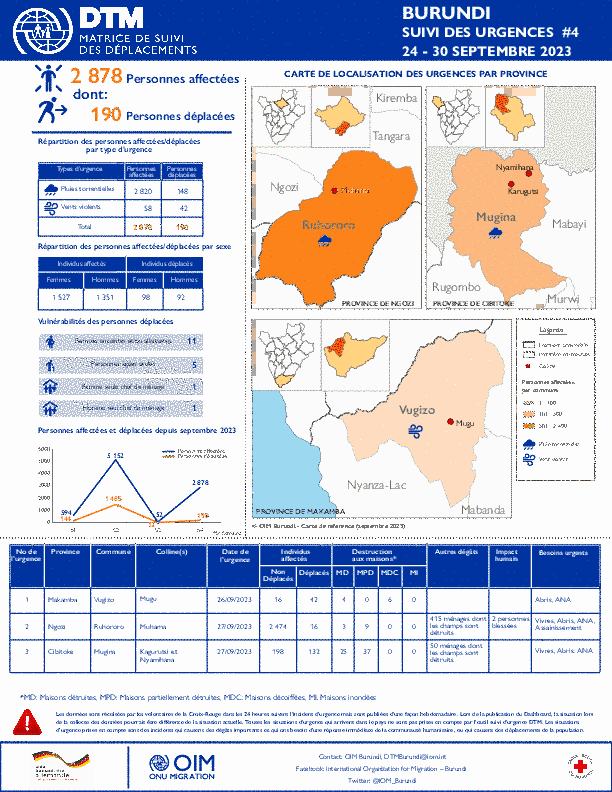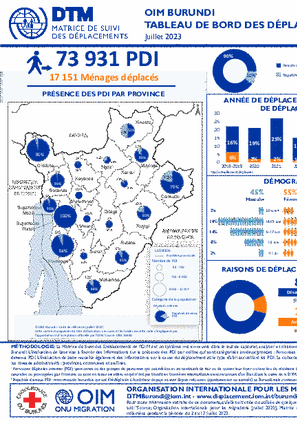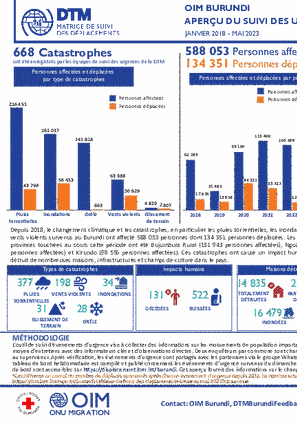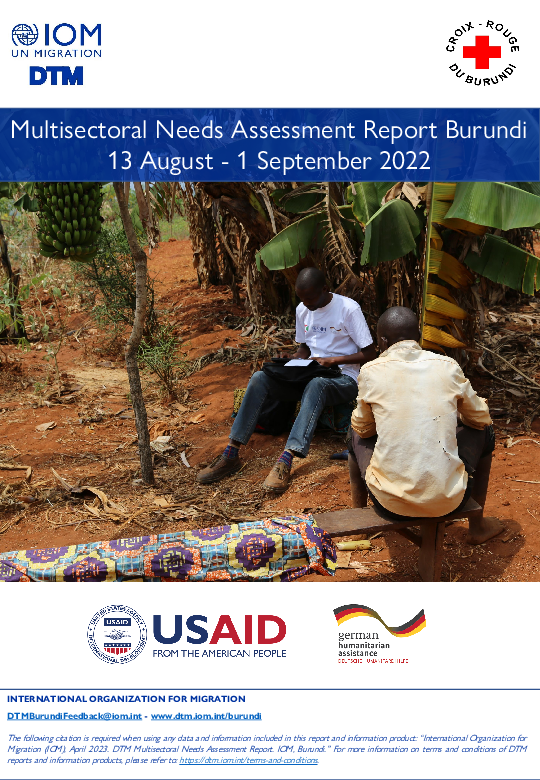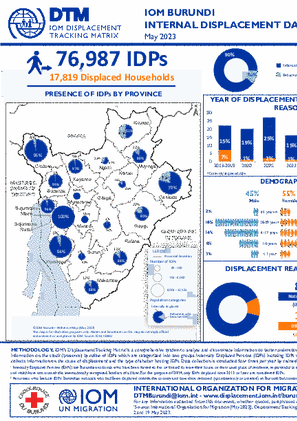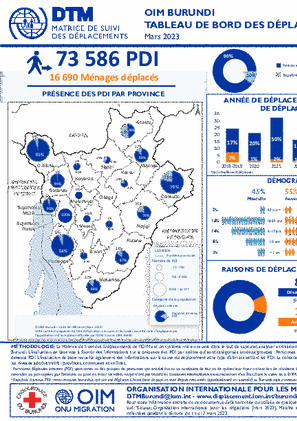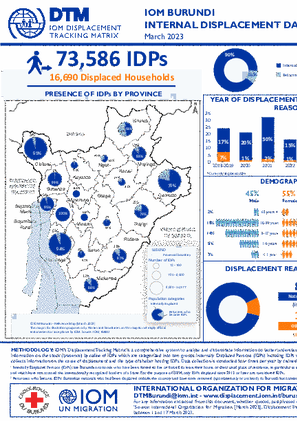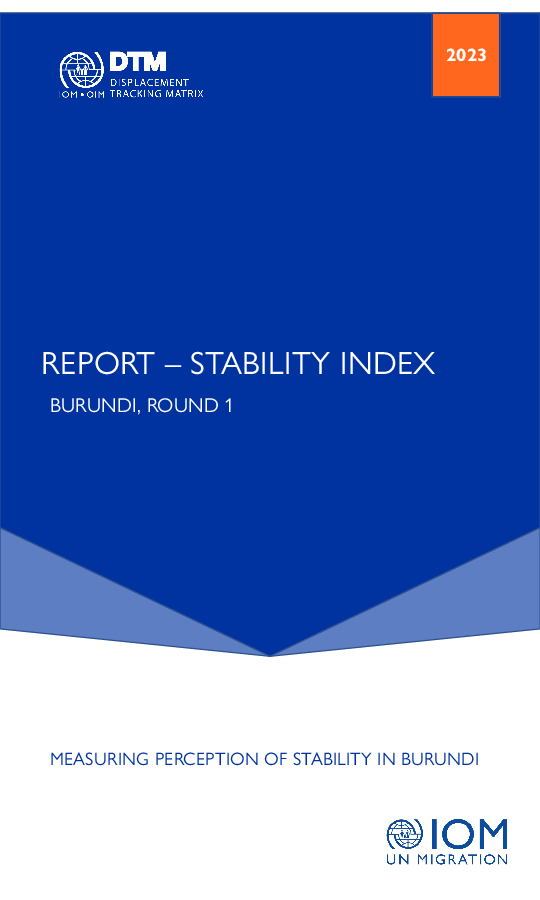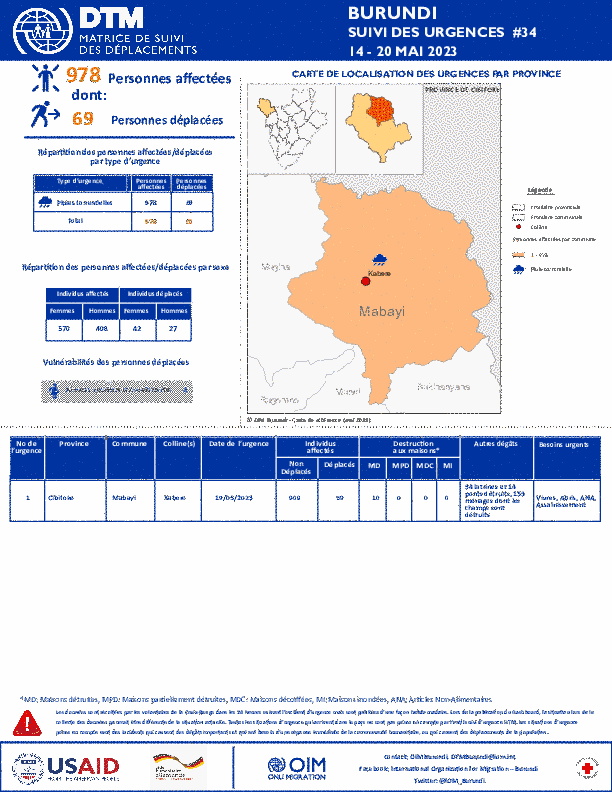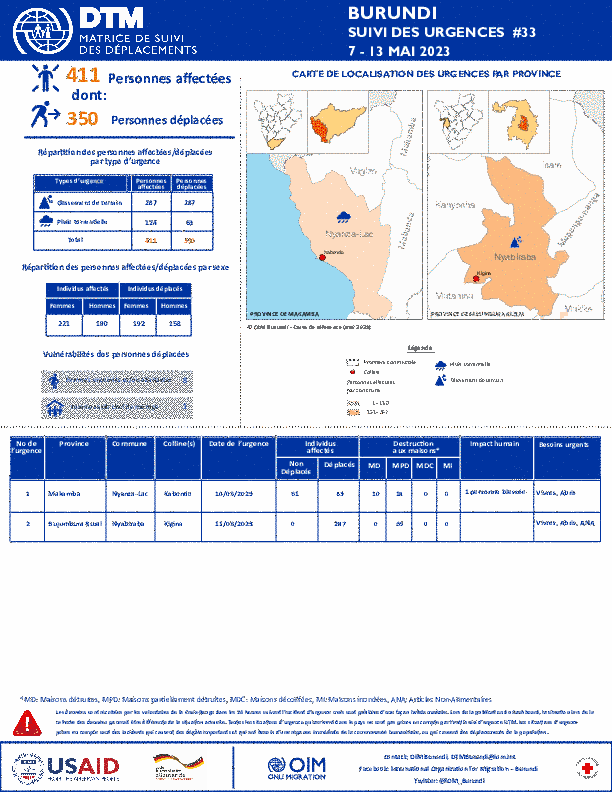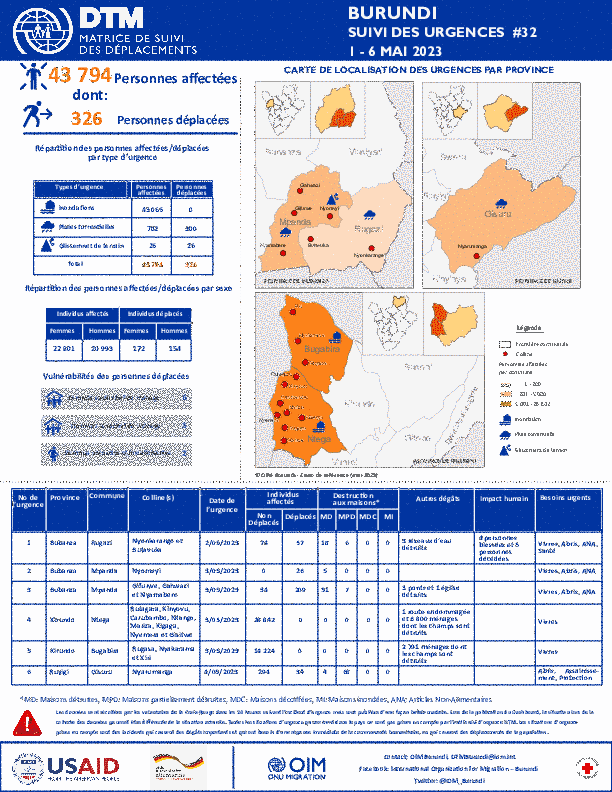-
Countries
-
Data and Analysis
-
Special Focus
-
Crisis Responses
Burundi
Burundi
Desplazados internos rastreados
Movimientos de desplazamiento
8,100
IDMC 2023
Ronda de recopilación de datos
Sobre Burundi
In response to the great need for information on internally displaced persons (IDPs), their humanitarian profile and needs, as identified by the humanitarian community and the Burundian authorities, the International Organization for Migration (IOM) implemented DTM since 2015 to effectively and systematically track and assess internal population flows in Burundi and therefore provide reliable information on the current situation of IDPs.
The Displacement Tracking Matrix monitors IDPs on a national level and to identify their humanitarian needs. The DTM’s main objective is to maintain a comprehensive system of data collection and sharing on IDPs. The project relies on the synergy between IOM's DTM and the Burundi Red Cross (BRC), who are jointly responsible for data collection on internally displaced persons. The collected data includes figures on displacement, as well as displacement centres, provenance locations, approximate duration of displacement and humanitarian needs of the displaced populations. The information collected at various levels contributes to the construction of an overall profile of the displaced population in targeted provinces, which can then be used by the government and the humanitarian partners in order to protect, assist and advocate for IDPs.
In November 2018, DTM Burundi also began to collect data on movement at unofficial points of transit on the Burundi - Tanzania border. The information collected at the flow monitoring points enable the government, humanitarian partners and policy stakeholders, to understand migration trends on the national and regional levels.
Contacto
DTMBurundi@iom.int
Current Donors
- PRM
- BHA
- Japan
- Republic of Korea
- Swiss (SDC)
- GFFO
Para obtener resultados de búsqueda más avanzados, vaya a la Página de búsqueda avanzada de informes
Evaluation du progrès vers une solution durable: Commune Gisagara de Cankuzo
En décembre 2022, une évaluation a été menée auprès des informateurs-clés pour renseigner sur la stabilité de 35 collines où se trouvent concurremment un grand nombre de personnes déplacées internes (PDI) et rapatriées provenant de cinq communes de la province de Cankuzo.
Evaluation du progrès vers une solution durable: Commune Busoni de Kirundo
En décembre 2022, une évaluation a été menée auprès des informateurs-clés pour renseigner sur la stabilité de 64 collines où se trouvent concurremment un grand nombre de personnes déplacées internes (PDI) et rapatriées provenant de sept communes de la province de Kirundo.
Burundi — Suivi des urgences (24 - 30 septembre 2023)
La DTM a identifié 2 878 personnes affectées dont 190 personnes déplacées par les vents violents et des pluies torrentielles dans les provinces de Makamba, Ngozi et Cibitoke.
Burundi — Tableau de bord des déplacements internes (juillet 2023)
La Matrice de Suivi des Déplacements de l’OIM est un système mis en œuvre dans le but de capturer, analyser et disséminer des informations pour mieux comprendre les mouvements et les besoins des personnes déplacées internes (PDI) au Burundi.
Burundi — Displacement Dashboard (July 2023)
IOM’s Displacement Tracking Matrix is a comprehensive system to analyse and disseminate information to better understand the movements and needs of Internally Displaced Persons (IDPs) in Burundi.
Oct 04 2023
Burundi — Displacement Dashboard (July 2023)
Burundi — Suivi des urgences (17 - 23 Septembre 2023)
La DTM a identifié 52 personnes affectées dont 12 personnes déplacées par les vents violents dans les province de Muyinga.
Burundi — Suivi des urgences (10 - 16 Septembre 2023)
La DTM a identifié 5 152 personnes affectées dont 1 485 personnes déplacées par les vents violents dans les provinces de Bujumbura Mairie, Muyinga, et Ruyigi.
Burundi — Suivi des urgences (03–09 Septembre 2023)
La DTM a identifié 594 personnes affectées dont 144 personnes déplacées par les vents violents dans les provinces de Bubanza et Muyinga.
Burundi – Déplacement interne: Rapport des Evaluations Multisectorielles des Localités (Mai 2023)
La DTM a identifié 76 987 personnes déplacées internes (PDI) dans 17 819 ménages déplacés dans les 18 provinces du Burundi au cours du mois d'mai 2023.
Burundi – Internal Displacement: Multisectoral Location Assessment Report (May 2023)
DTM identified 76,987 Internally Displaced Persons (IDPs) in 17,819 displaced households in the 18 provinces of Burundi during the month of May 2023. Among those identified, 89 per cent were displaced due to environment-related disasters while 11 per cent were a result of other reasons.
Aperçu du changement climatique et des catastrophes ( Janvier 2018 - Mai 2023)
Depuis 2018, les désastres naturels, en particulier les pluies torrentielles, les inondatons et les vents violents survenus au Burundi ont affecté 588 053 personnes dont 134 351 personnes déplacées.
Burundi - Climate change and Disaster Overview (January 2018 - May 2023)
Since 2018, natural disasters, in particular torrential rains, floods and strong winds that occurred in Burundi affected 588,053 persons, including 134,351 individuals that have been displaced.
Burundi - Rapport d'évaluation des besoins multisectoriels – (Septembre 2022)
L'OIM a mis en oeuvre le premier MSNA au Burundi en août 2022, en collaboration avec le gouvernement du Burundi, le système de clusters et les agences internationales et nationales qui ont toutes contribué à façonner l'évaluation.
Jul 26 2023
Burundi - Rapport d'évaluation des besoins mu…
Burundi - Multisectoral Assessment of Needs Report – (September 2022)
The 2022 Burundi's Multi Sector Needs Assessment (MSNA) conducted by IOM seeks to understand multi-sectoral priority needs of displacement-affected populations living across the whole of Burundi and the progress towards the achievement of durable solutions.
Burundi — Internal Displacement Dashboard (May 2023)
IOM’s Displacement Tracking Matrix is a comprehensive system to analyse and disseminate information to better understand the movements and needs of Internally Displaced Persons (IDPs) in Burundi.
Burundi — Tableau de bord des déplacements internes (Mai 2023)
La Matrice de Suivi des Déplacements de l’OIM est un système mis en œuvre dans le but de capturer, analyser et disséminer des informations pour mieux comprendre les mouvements et les besoins des personnes déplacées internes (PDI) au Burundi.
Burundi – Tableau de bord des déplacements internes (Mars 2023)
La DTM a identifié 73 586 personnes déplacées à l'intérieur du pays (PDI) dans 16 690 ménages. Presque tous les déplacements étaient dus à des catastrophes naturelles (89 %), tandis que 11 % étaient dus à d'autres raisons.
Burundi – Internal Displacement Trends (March 2023)
DTM has identified 73,586 internally displaced persons (IDPs) in 16,690 households. Almost all displacements were due to natural disasters (89%), while 11% were due to other reasons.
Burundi - Indice de Stabilité Round 1 (Mai 2023)
En mai 2020, le Burundi a organisé ses premières élections générales depuis 2015. Depuis l'inauguration du nouveau gouvernement en juin 2020, le pays a connu des améliorations notables en termes de sécurité et de situation politique et socio-économique.
Jun 08 2023
Burundi - Indice de Stabilité Round 1 (Mai 2023)
Burundi – Stability Index Round 1 (May 2023)
In May 2020, Burundi held its first general elections since 2015. Since the inauguration of the new government in June 2020, the country has seen significant improvements in security, political and socio-economic conditions.
Jun 08 2023
Burundi – Stability Index Round 1 (May 2023)
Burundi — Suivi des urgences (14-20 Mai 2023)
La DTM a identifié 978 personnes affectées dont 69 personnes déplacées par les pluies torrentielles et les vents violents dans le province de Cibitoke.
May 24 2023
Burundi — Suivi des urgences (14-20 Mai 2023)
Burundi — Suivi des urgences (7 - 13 Mai 2023)
La DTM a identifié 411 personnes affectées dont 350 personnes déplacées par les pluies torrentielles et les glissements de terrain dans les provinces de Makamba et Bujumbura Rural.
May 17 2023
Burundi — Suivi des urgences (7 - 13 Mai 2023)
Burundi — Suivi des urgences (1 - 6 Mai 2023)
La DTM a identifié 43 794 personnes affectées dont 326 personnes déplacées par les inondations, les pluies torrentielles et les glissements de terrain dans les provinces de Bubanza, Kirundo et Ruyigi.
May 10 2023
Burundi — Suivi des urgences (1 - 6 Mai 2023)
Burundi — Suivi des urgences (23-30 Avril 2023)
La DTM a identifié 6 742 personnes affectées dont 327 personnes déplacées par les pluies torrentielles et les vents violents dans les provinces de Cibitoke, Muyinga et Kirundo.
May 02 2023
Burundi — Suivi des urgences (23-30 Avril 2023)
Pagination
Para obtener resultados de búsqueda más avanzados, vaya a la Página de búsqueda avanzada de conjuntos de datos
Burundi - Multi-Sectoral Location Assessment - Round 2
2022-10-19
As of October 2022, the main cause of displacement was natural disasters (89%). Most IDPs (46%) were hosted in the provinces of Rumonge (19%), Cibitoke (14%), and Cankuzo (13%). Even though natural disasters were the main displacement reason, a considerable share of IDPs in the provinces of Mwaro (…
Burundi — Baseline Assessment — Round 69
2022-07-24
A baseline assessment is a sub-component of mobility tracking. It aims to collect data on IDP, migrant or returnee population presence in a defined administrative area of the country.
Burundi — Multi Sectoral Location Assessment — Round 1
2022-05-03
A site assessment is a sub-component of mobility tracking. It aims to collect data on population presence, living conditions and needs in a particular displacement site or community.
Burundi — Baseline Assessment — Round 68
2022-04-20
A baseline assessment is a sub-component of mobility tracking. It aims to collect data on IDP, migrant or returnee population presence in a defined administrative area of the country.
Burundi — Baseline Assessment — Round 67
2022-02-18
A baseline assessment is a sub-component of mobility tracking. It aims to collect data on IDP, migrant or returnee population presence in a defined administrative area of the country.
Burundi — Baseline Assessment — Round 66
2021-09-18
A baseline assessment is a sub-component of mobility tracking. It aims to collect data on IDP, migrant or returnee population presence in a defined administrative area of the country.
Burundi — Baseline Assessment — Round 65
2021-08-21
A baseline assessment is a sub-component of mobility tracking. It aims to collect data on IDP, migrant or returnee population presence in a defined administrative area of the country.
Burundi — Baseline Assessment — Round 64
2021-07-19
A baseline assessment is a sub-component of mobility tracking. It aims to collect data on IDP, migrant or returnee population presence in a defined administrative area of the country.
Burundi — Baseline Assessment — Round 63
2021-06-22
A baseline assessment is a sub-component of mobility tracking. It aims to collect data on IDP, migrant or returnee population presence in a defined administrative area of the country.
Burundi — Baseline Assessment — Round 62
2021-05-28
A baseline assessment is a sub-component of mobility tracking. It aims to collect data on IDP, migrant or returnee population presence in a defined administrative area of the country.
Burundi — Baseline Assessment — Round 61
2021-04-20
A baseline assessment is a sub-component of mobility tracking. It aims to collect data on IDP, migrant or returnee population presence in a defined administrative area of the country.
Burundi — Baseline Assessment — Round 60
2021-03-30
A baseline assessment is a sub-component of mobility tracking. It aims to collect data on IDP, migrant or returnee population presence in a defined administrative area of the country. During this assessment, DTM has identified 109,169 internally displaced persons (IDPs) and 25,380 households…
Burundi — Baseline Assessment — Round 59
2021-02-25
A baseline assessment is a sub-component of mobility tracking. It aims to collect data on IDP, migrant or returnee population presence in a defined administrative area of the country.
Burundi — Baseline Assessment — Round 58
2021-01-29
A baseline assessment is a sub-component of mobility tracking. It aims to collect data on IDP, migrant or returnee population presence in a defined administrative area of the country.
Burundi — Baseline Assessment — Round 57
2020-12-29
A baseline assessment is a sub-component of mobility tracking. It aims to collect data on IDP, migrant or returnee population presence in a defined administrative area of the country. During this round, DTM Burundi has identified 115,221 internally displaced persons (IDPs) and 25,880 households.
Burundi — Baseline Assessment — Round 56
2020-11-24
A baseline assessment is a sub-component of mobility tracking. It aims to collect data on IDP, migrant or returnee population presence in a defined administrative area of the country.
Burundi — Baseline Assessment — Round 55
2020-09-26
A baseline assessment is a sub-component of mobility tracking. It aims to collect data on IDP, migrant or returnee population presence in a defined administrative area of the country.
Burundi — Baseline Assessment — Round 54
2020-07-21
A baseline assessment is a sub-component of mobility tracking. It aims to collect data on IDP, migrant or returnee population presence in a defined administrative area of the country.
Burundi — Baseline Assessment — Round 53
2020-06-26
A baseline assessment is a sub-component of mobility tracking. It aims to collect data on IDP, migrant or returnee population presence in a defined administrative area of the country.
Burundi — Baseline Assessment — Round 52
2020-05-02
A baseline assessment is a sub-component of mobility tracking. It aims to collect data on IDP, migrant or returnee population presence in a defined administrative area of the country.




